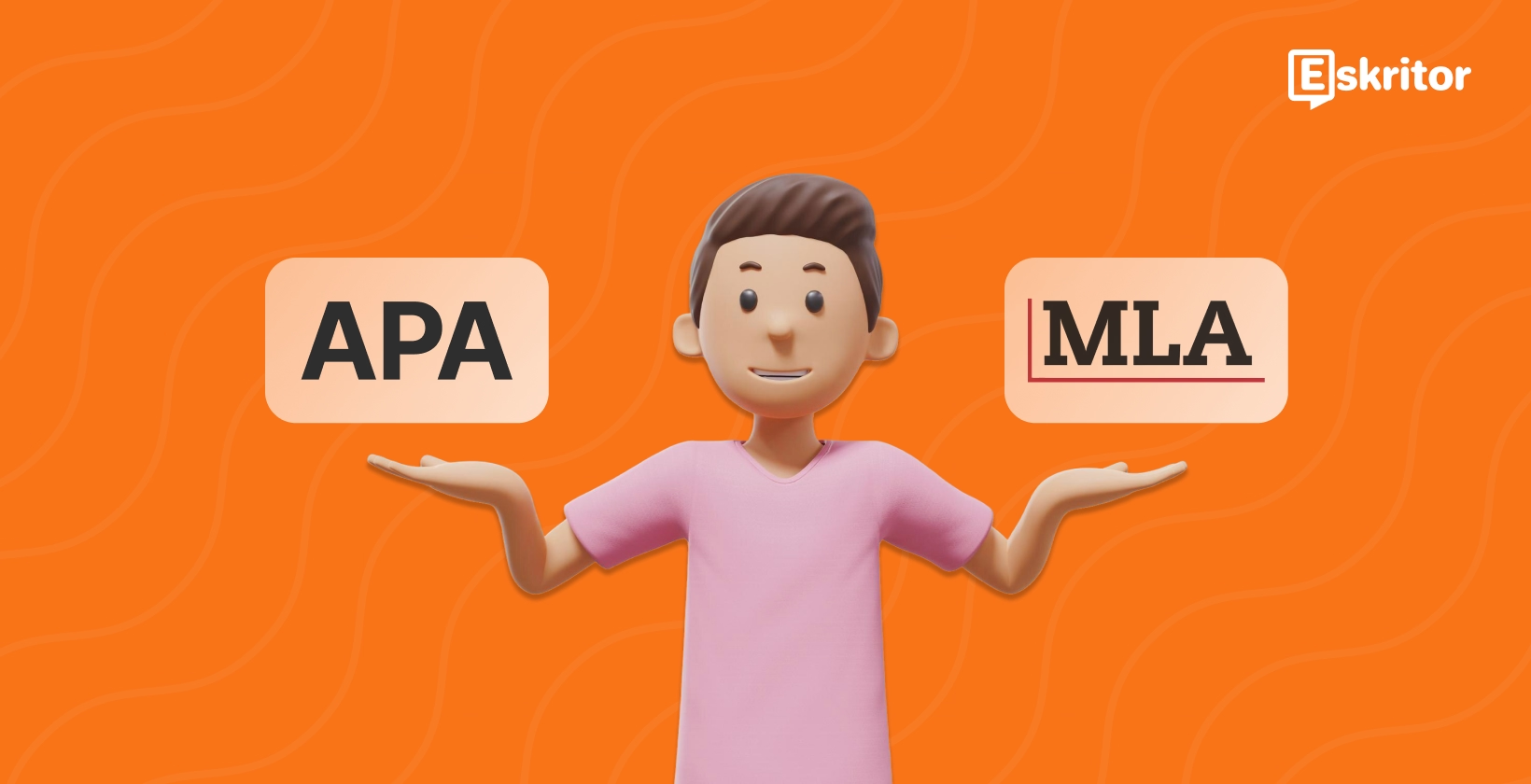
APA vs. MLA Citation: When to Use Which Format
Generate the Best Content with AI in Seconds
Generate the Best Content with AI in Seconds
APA and MLA citation formats differ in how they organize information, format in-text citations, and structure reference lists. Understanding how to write an essay effectively can help you decide which citation style to use. For example, APA style uses the author’s last name followed by the year of publication in parentheses, such as (Smith, 2020), while MLA style cites the author’s last name and page number without a comma, like (Smith 24). In the reference list, APA includes the full date and capitalizes only the first word of titles, whereas MLA lists the publication year later and capitalizes all major title words.
These distinctions reflect the unique priorities of each discipline. APA is commonly used in the social sciences to highlight the timeliness of research, while MLA is preferred in the humanities, where detailed textual references are more important. Understanding these differences allows writers to apply the appropriate style based on the expectations of their academic field, showcasing the importance of formal writing.
What is APA Format?

APA (American Psychological Association) format is a citation style widely used in the social sciences that provides guidelines for formatting papers and citing sources in academic writing. Developed to create consistency in scientific documentation, APA has become the standard for many disciplines that emphasize data-driven research and analysis. A comprehensive APA citation guide is essential for anyone writing in fields like psychology, education, or nursing.
What Is the Purpose of APA Style?
The American Psychological Association established this format in 1929 to standardize scientific writing. The style has evolved through multiple editions, with the 7th edition being the current standard. Researchers and students alike rely on these guidelines to create clear, consistent academic papers that effectively communicate complex research findings.
The APA style was designed for:
- Creating clarity in scientific reporting
- Establishing consistent formatting across social science publications
- Providing precise methods for crediting sources
What Are the Key Characteristics of APA Format?
APA format has several distinctive features that help identify it in academic writing. These characteristics establish a consistent structure that readers familiar with the style can easily navigate and understand.
APA format has several distinctive features:
- In-text Citations : Uses author-date citations (Smith, 2023)
- Emphasis on Date : Publication dates are prominently featured
- Title Page : Includes a structured title page with paper title, author names, and institutional affiliation
- Abstract : Often requires a brief summary (150-250 words)
- Reference List Format : Alphabetical listing with hanging indents
Example APA reference for a book: Smith, J. D. (2023). Understanding citation formats: A comprehensive guide . Academic Press.
When to Use APA Citation Format?
Knowing when to apply APA format is crucial for academic success in many disciplines. Understanding the contexts where APA is preferred will help you make appropriate formatting choices for your assignments and publications.
APA is the preferred style in many disciplines:
- Psychology and behavioral sciences
- Education
- Social work
- Business
- Nursing and health sciences
You should use APA format when:
- Your instructor specifically requires it
- You're writing in the social science fields
- Your research emphasizes recent developments
- You're citing scientific studies and journal articles
What is MLA Format?
MLA (Modern Language Association) format is a citation style commonly used in the humanities that provides a standardized way to give credit to sources. This style emphasizes the author and the specific location within a source, making it ideal for literary analysis and textual criticism. For anyone writing in literature, language, or cultural studies, a thorough MLA citation guide is an invaluable resource.
What Is the Purpose of MLA Style?
The Modern Language Association developed this format to create consistency in documentation practices across humanities disciplines. First introduced in 1951, the style has evolved with the 9th edition being the most current. The guidelines help writers in literary and cultural studies present their research in a clear, uniform manner that highlights textual evidence.
MLA style was established to:
- Provide uniform guidelines for humanities research
- Create a flexible system for citing diverse source types
- Emphasize the author and page number as key reference points
- Allow readers to easily find cited passages
What Are the Key Characteristics of MLA Format?
MLA format has distinct features that set it apart from other citation styles. These characteristics support the close reading and textual analysis common in humanities research by making it easy to trace references to specific passages.
MLA format has several distinctive features:
- In-text Citations : Uses author-page number citations (Smith 42)
- No Title Page : Generally doesn't require a separate title page
- Header Format : Includes student name, instructor name, course, and date on first page
- Works Cited Page : Lists sources alphabetically by author's last name
- Page Headers : Includes student's last name and page number in the upper right corner
Example MLA Works Cited entry for a book: Smith, John D. Understanding Citation Formats: A Comprehensive Guide . Academic Press, 2023.
When to Use MLA Citation Format?
Knowing the appropriate context for MLA citation is important for students and researchers in the humanities. The format's emphasis on textual evidence makes it particularly suitable for certain types of academic writing and specific disciplines.
MLA is the standard style in many disciplines:
- Literature and literary criticism
- Language studies
- Cultural studies
- Arts
- Philosophy
- History
You should use MLA format when:
- Your instructor specifically requires it
- You're writing in the humanities disciplines
- You're analyzing literary texts
- You're citing multimedia and digital sources
- Your paper emphasizes textual analysis
When to use MLA format generally correlates with humanities-focused writing, where close reading and analysis of texts are central to the argument. Understanding different [types of essays](https://eskritor.com/types-of-essays/) can inform your choice of citation format. MLA's streamlined citation approach, which emphasizes page numbers rather than publication dates, reflects the humanities' focus on the content of texts rather than their historical placement in a research timeline.
How Do APA and MLA Citations Differ?
Understanding the distinctions between APA and MLA formats proves essential for applying them correctly in academic writing. These differences reflect the distinct values and priorities of different academic disciplines and documentation traditions. Recognizing these contrasts helps writers maintain consistency and meet the expectations of instructors or publishers.
What Are the In-Text Citation Differences?
In-text citations directly reference sources within the body of academic papers. The formatting differences between APA citation and MLA citation reflect the different emphasis each style places on certain types of bibliographic information.
APA In-Text Citations:
- Include the author's last name and publication year: (Smith, 2023)
- For direct quotes, add page number: (Smith, 2023, p. 42)
- Two authors: (Smith & Jones, 2023)
- Three or more authors: (Smith et al., 2023)
MLA In-Text Citations:
- Include the author's last name and page number without a comma: (Smith 42)
- No publication year required in the citation
- Two authors: (Smith and Jones 42)
- Three or more authors: (Smith et al. 42)
How Do Reference Lists and Works Cited Pages Compare?
The method for compiling sources at the end of academic papers differs significantly between the APA citation format and the MLA citation format. These differences affect not only how the information appears but also what bibliographic information receives emphasis.
APA Reference List:
- Labeled "References" as the section heading
- Publication date appears after the author's names in parentheses
- Titles use sentence case (only the first word and proper nouns capitalized)
- Includes DOI (Digital Object Identifier) when available
- Emphasizes the publisher location and name
MLA Works Cited:
- Labeled "Works Cited" as the section heading
- The publication date appears toward the end of the citation
- Titles of articles appear in quotation marks; titles of larger works are italicized
- Titles use title case (all major words capitalized)
- Emphasizes the medium of publication
What Formatting Guidelines Distinguish the Citation Styles?
The overall formatting of academic papers varies between APA and MLA documentation styles. Understanding these differences helps writers properly structure entire documents, not just the citations.
APA Formatting Guidelines:
- Requires a formal title page with specific elements
- Includes a running head on each page for identification
- Requires an abstract (usually 150-250 words) summarizing the content
- Uses section headings to organize content hierarchically
- Implements double-spacing throughout the document
MLA Formatting Guidelines:
- Excludes separate title page (unless specifically requested)
- Places the header in the upper-left corner of the first page with personal information
- Position the age number and the student's last name in the upper-right corner
- Center the title before beginning the main text
- Implements double-spacing throughout the document
These formatting differences reflect disciplinary priorities: APA emphasizes dates, highlighting the importance of recency in scientific research, while MLA focuses on page numbers, facilitating the analysis of specific passages in literary works.
How to Choose Between APA and MLA Formats?
Selecting between APA citation style and MLA citation style follows logical patterns based on academic context and content type. Understanding when to use APA format versus when to use MLA format strengthens academic writing and demonstrates scholarly competence within discipline-specific conventions.
What Academic Discipline Considerations Apply?
The most reliable indicator for choosing citation style remains the academic field. This distinction isn't arbitrary—each discipline has developed citation conventions that support its unique research approaches and analytical methods.
Social Sciences gravitate toward APA citation:
- Psychology: Emphasizes experimental design and recent findings
- Sociology: Values current research and empirical studies
- Education: Focuses on evolving educational theories and practices
- Business: Prioritizes contemporary case studies and market analysis
- Nursing & Health Sciences: Requires up-to-date clinical research
Humanities embrace MLA citation:
- Literature: Centers on close textual reading and analysis
- Philosophy: Examines original texts and their interpretations
- Art History: Analyzes creative works and critical commentary
- History: Evaluates primary sources and historical documents
- Language Studies: Investigates linguistic patterns and usage examples
This division exists because social science research typically builds on recent discoveries, making publication dates crucial (APA's specialty). Humanities scholarship often involves analyzing specific passages from texts, making page numbers essential for verification (MLA's strength).
How Do Publication Requirements Impact Citation Choice?
While disciplinary conventions provide general guidance, specific citation requirements from authoritative sources should always take precedence:
- Academic Assignments: Professor requirements always supersede general rules—check syllabus and assignment instructions
- Departmental Guidelines: Some departments maintain their own citation preferences that may differ from broader disciplinary standards
- Journal Submissions: Publications often provide detailed style guides that modify standard formats
- Thesis Committees: Graduate committees may implement specific formatting requirements beyond basic citation styles
When requirements seem unclear, requesting clarification before submitting work can prevent significant revision time and potential grade penalties.
How Should Content and Source Material Affect Format Selection?
The nature of sources and how writers use them should influence citation format selection:
Choose APA citation format when the work:
- Emphasizes research recency and chronological development of ideas
- Relies primarily on peer-reviewed journal articles and scientific publications
- Presents statistical data, research findings, and experimental results
- Focuses on theoretical frameworks that evolve over time
- Discusses methodological approaches and their developments
Choose MLA citation format when the work:
- Centers on analyzing specific texts, creative works, or cultural artifacts
- Features frequent direct quotations requiring precise page references
- Incorporates diverse source types, including multimedia, performances, or artworks
- Examines language patterns, rhetorical devices, or literary techniques
- Discusses historical context and interpretive traditions
Understanding these distinctions helps writers not only format correctly but also structure analysis in ways that align with disciplinary expectations and documentation standards.
What Are the Best Citation Tools?
Creating perfect citations manually can be time-consuming and error-prone. Fortunately, several citation tools for APA and MLA are available to streamline the documentation process. Using appropriate citation resources significantly reduces formatting errors and saves valuable research and writing time.
Eskritor
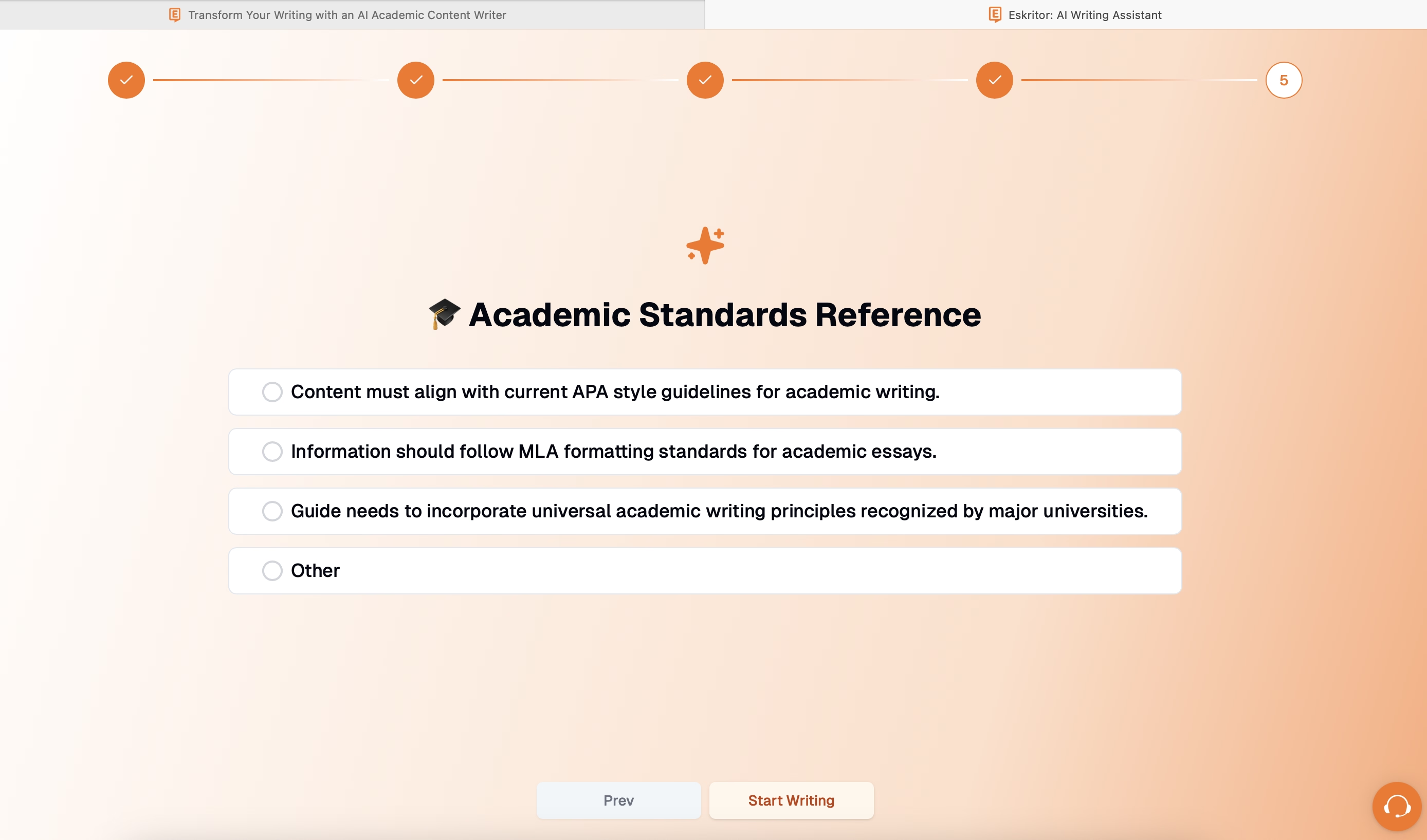
Eskritor citation tool provides an AI-powered writing assistant that makes citation formatting straightforward and error-free. It integrates citation support directly into the writing process, creating a seamless workflow for academic papers requiring proper documentation.
The Eskritor citation generator offers these advantages:
- Automated Citation Generation: Input source information and get properly formatted citations in APA, MLA, and other styles, eliminating the need to memorize complex formatting rules.
- In-text Citation Support: Generates both in-text citations and reference list entries that match perfectly, ensuring consistency throughout your document.
- Format Checking: Scans for citation errors and formatting inconsistencies, catching mistakes that might otherwise go unnoticed.
Pros:
- Supports multiple citation styles (APA, MLA, Chicago, etc.)
- Generates both in-text and full citations
- Detects formatting errors automatically
- Seamless integration with writing workflow
Cons:
- Limited research capabilities
Zotero
Zotero is a free reference management tool that helps users collect, organize, and cite sources directly from their browser. It automatically captures citation information from webpages, academic journals, and PDFs, allowing users to build a searchable library of references that can be used across documents.

Pros:
- Free and open-source
- Browser integration for quick source capture
- Strong organizational tools with tagging and folders
Cons:
- The interface can feel outdated
- Syncing across devices requires setup and an account
Mendeley
Mendeley combines reference management with academic networking and PDF annotation. It allows users to highlight and comment on PDFs while saving citation data, making it especially useful for researchers handling large volumes of literature.
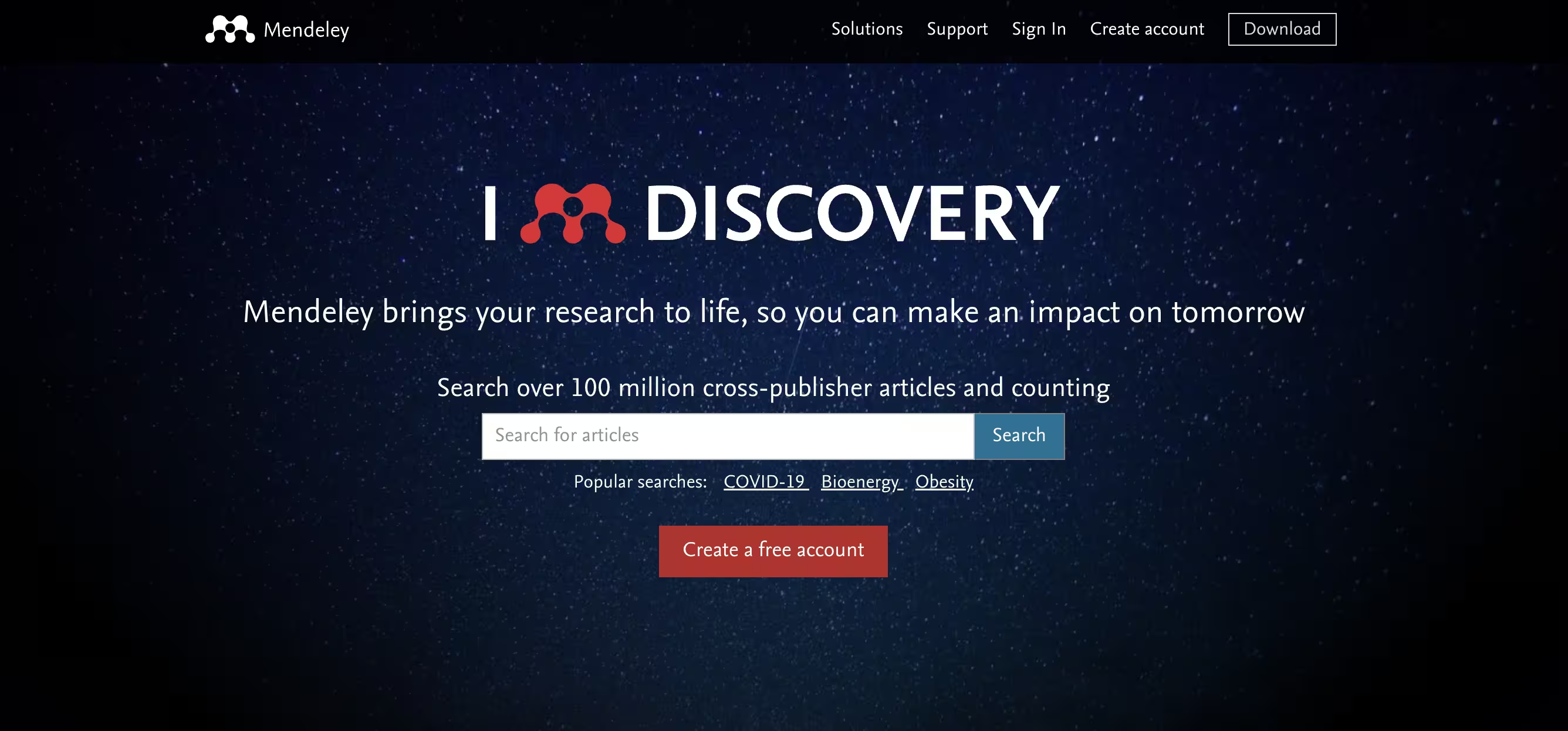
Pros:
- Built-in PDF viewer and annotation tools
- Supports citation syncing across devices
- Offers research collaboration and discovery features
Cons:
- Requires installation for full functionality
- Some advanced features are limited to premium users
EndNote
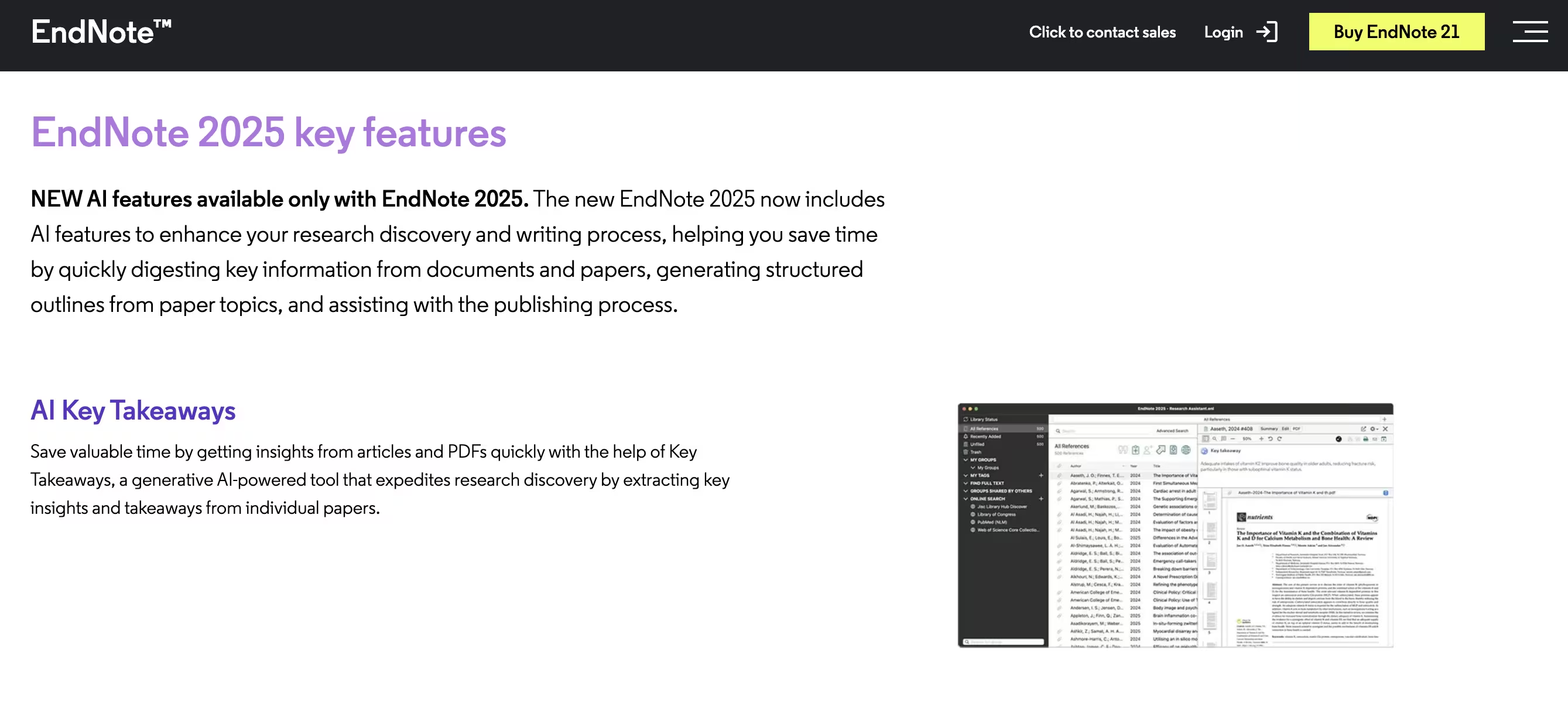
EndNote is a comprehensive reference management tool favored by researchers working on large, complex projects. It offers powerful features like citation style customization, full-text search within your library, and advanced organization tools for managing hundreds or thousands of sources.
Pros:
- Ideal for managing large bibliographies
- Custom citation style creation
- Advanced search and filtering options
Cons:
- Expensive compared to alternatives
- Steeper learning curve for new users
Citation Machine
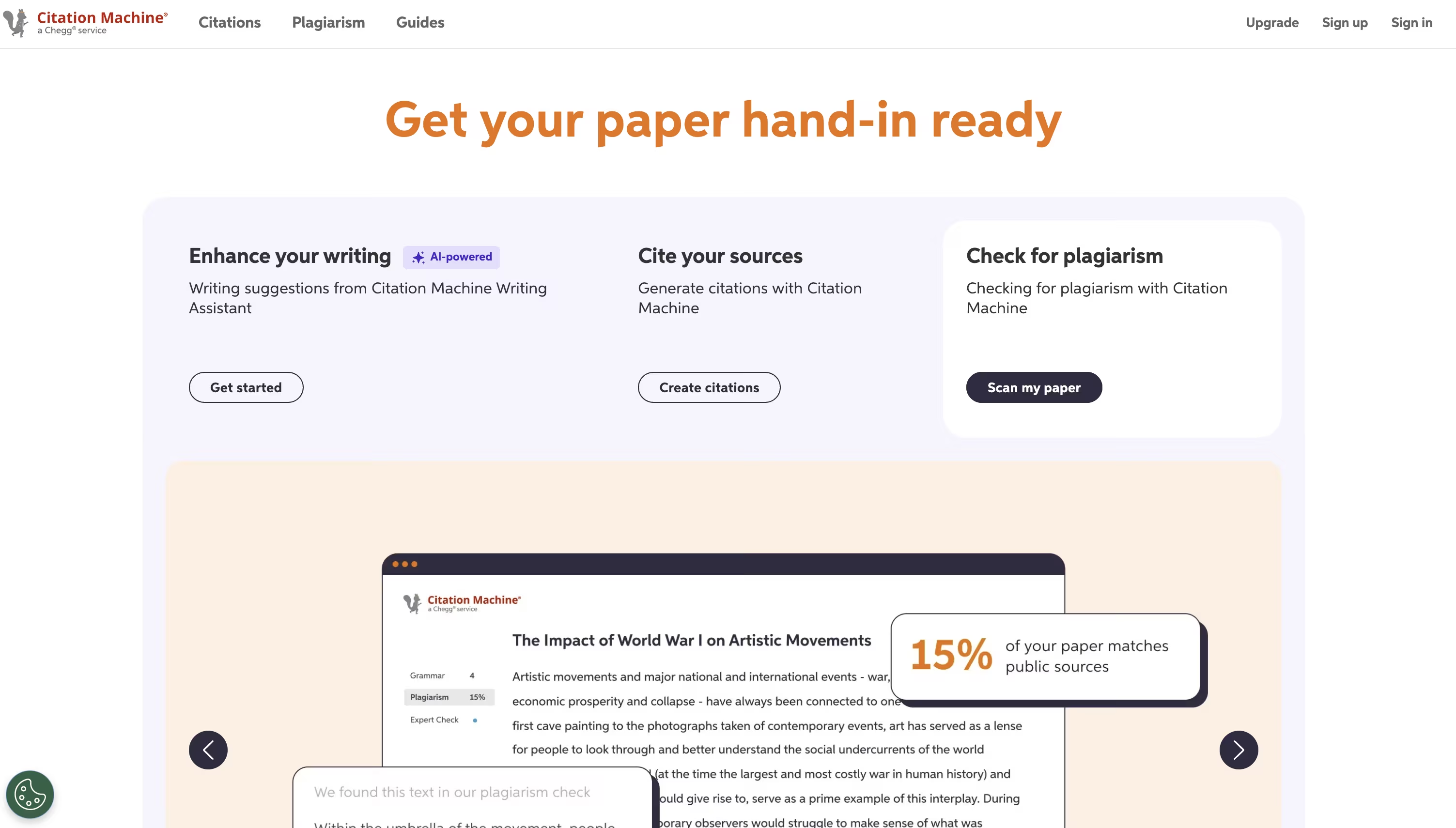
Citation Machine allows users to generate citations in various styles by entering source details manually. It's particularly helpful for quick citation creation and is commonly used by students for one-time projects or assignments.
Pros:
- Simple and quick to use
- Supports a wide range of citation styles
- No login required for basic functionality
Cons:
- Contains ads and upsells
- Manual input can lead to user error
EasyBib
EasyBib provides a user-friendly platform for creating citations with guided, step-by-step inputs. It's designed with students in mind, helping them avoid citation mistakes and offering grammar and plagiarism checks as part of its premium features.
Pros:
- Beginner-friendly with step-by-step prompts
- Grammar and plagiarism tools included
- Easily exports to Microsoft Word or Google Docs
Cons:
- The free version has limited features
- Ads and distractions on the free version
Conclusion
Mastering the differences between APA and MLA citation formats is essential for academic success, as it can also guide you on when to paraphrase information. While they may seem like mere formatting details, using the appropriate citation style demonstrates your understanding of disciplinary conventions. Proper citation not only avoids plagiarism but also shows your ability to engage with scholarly conventions in your field.
Remember these key points:
- APA format emphasizes research recency and is primarily used in social sciences
- MLA format focuses on textual analysis and is the standard in the humanities
- Your choice should be guided by your discipline, instructor requirements, and source types
Eskritor simplifies the citation process by automatically formatting your references while supporting your entire writing workflow. Start using Eskritor today to produce perfectly formatted academic papers and focus on developing your ideas rather than worrying about citation details.
Frequently Asked Questions
The main difference is that APA emphasizes publication dates (using author-year citations) while MLA emphasizes page numbers (using author-page citations). APA is typically used in social sciences, while MLA is standard in humanities disciplines.
APA in-text citations include the author's last name and publication year in parentheses (Smith, 2023). For direct quotes, add a page number after the year (Smith, 2023, p. 42). Multiple authors follow specific formatting rules.
In APA, the reference list is titled "References" and includes the author’s last name followed by initials, with the year in parentheses. MLA uses the title "Works Cited," lists full first names, and does not include the publication year after the author’s name.
With Eskritor, you can switch between citation styles with a single click. The platform automatically reformats all existing citations to match your selected style, eliminating the need for manual adjustments throughout your document.
No, academic papers should stick to one consistent citation style throughout. Mixing citation styles can confuse readers and reduce credibility. Tools like Eskritor help maintain style consistency across your entire document.





 location
location